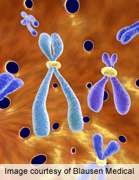For American Indians, leukocyte telomere length is associated with the risk of incident diabetes, with an almost two-fold increased risk for those with the shortest versus the longest length, according to a study published online Aug. 15 in Diabetes.
(HealthDay)—For American Indians, leukocyte telomere length is associated with the risk of incident diabetes, with an almost two-fold increased risk for those with the shortest versus the longest length, according to a study published online Aug. 15 in Diabetes.
Jinying Zhao, M.D., Ph.D., from Tulane University in New Orleans, and colleagues investigated whether leukocyte telomere length at baseline predicts incident diabetes, independent of known diabetes risk factors, in a cohort of 2,328 American Indians free of diabetes at baseline participating in the Strong Heart Family Study.
During an average follow-up of 5.5 years, the researchers found that 292 participants developed diabetes. Those in the lowest quartile (shortest) leukocyte telomere length had a significantly increased risk of diabetes compared with those in the highest quartile (hazard ratio, 1.83). The risk for those in the second and third quartiles was not significant.
"These findings suggest a non-linear association between leukocyte telomere length and incident diabetes, and indicate that leukocyte telomere length could serve as a predictive marker for diabetes development in American Indians, who suffer from disproportionately high rates of diabetes," the authors write.
More information:
Abstract
Full Text (subscription or payment may be required)
Journal information: Diabetes
Copyright © 2013 HealthDay. All rights reserved.






















